Ok, what? What am I talking about? Here. Read this, from The Moose Book, published in 1916.
…A military chaplain (Rev. Joshua Fraser) writing of a dinner in an Indian camp on the upper Ottawa thus describes a dish of muffle ‘The crowning dish was that grandest of all dishes moose mouffle. This is the immense upper lip and nostrils of the animal, and I have no hesitation in pronouncing it one of the most toothsome and savoury of all the dishes within the range of the gastronomic art. It is white and tender as spring chicken, yet firm and substantial as fresh beef, with a flavor combining the excellencies of both. I eat to repletion, yet was not sensible of any of that uneasy heaviness which generally follows a too hearty meal.’
The edible portion of the muffle comprises the fibrous flesh of the cheek and the gelatinous prehensile upper lip. The cartilaginous nasal septum is, of course, not eaten… When I shot my first moose the guide who was something of an epicure and a skillful cook withal described stewed muffle in terms of extravagant praise. His mouth fairly watered at thoughts of royal banquets in the woods when simply a dish of muffle with pilot bread and tea had constituted the menu.
This is not even the first and only place I’ve read about moose mouffle, you can read more about it here. It’s even mentioned in the Joy of Cooking.
When the idea of mouffle was first presented to me, my curiousity was peaked. I placed a call to my friends in Alaska, who called thier friends, and an APB was put out: should someone take down a moose, please save the mouffle for Sarah Lohman.
A year passed. Attempts were made, but a moose was never felled. Then, one day, I was tramping through the wilds of South Dakota. I was there for a wedding, in a spot far outside the realm of internet connections and cell phones. On my first night there, I got a chance to check my email: I found a dozen desperate messages, facebook posts, and later, voicemails–they had got a moose. They needed to send my the mouffle, NOW.
It wasn’t doable; I wouldn’t be back in New York for a week. So we took the risk of freezing the mouffle, even thought it might affect the flavor, and it was shipped to me when I returned home. It arrived via fed ex, and I opened the cooler to find a huge trashbag, just barely reaveling something large, bloody and hairy within. I stuck it on the bottom shelf of my refrigerator, too terrified to look. They also generously sent me a big, floppity, moose tongue as a bonus prize.
As part of the deal, my arctic providers require that I serve my cooking to at least one other person besides myself. So I sent out a facebook invitation:
Let’s call it mystery meat. It’s large and from Alaska, and hopefully it will taste good. I’ll reveal the ingredients when you arrive. It’s not any kind of genitalia. Please come?
And to my great surprise, people did indeed come. But I’m getting ahead of myself–the day of the feast, preparations began eight hours ahead of time. Beware–there is some gruesome content below.
The tongue was easy part. It was large, and bloody, but also looked less terrfying than beef. It didn’t smell very good, and I had to trim some bristly hairs off of it. To cook it, I used a historic recipe and a modern crookpot, which you can read about here.
When I was brave enough to open the bag of thawed mouffle, I discovered literally half a moose face, hair and all. I am not a skilled butcher, I have done very little breaking down of my own meat, let alone skinning half the head of a wild animal.
I knew I needed to start by removing the hair, so I googled up a plan to scald the moose head (here). I set a huge pot of water on the stove, waiting until it was steaming, and dunked in my moose face.
Wet moose stinks. And I didn’t scald it right: when I pulled out the moose face, the fur was still firmly attached, and the flesh was slighty cooked. I fucked up. The hair, which should scrape off easily, was immovable. I tried hacking away at the skull to skin it, hair and all, with little result. At this point, I was standing in my kitchen, wrestling half a moose head, in near tears. The house stunk of boiled moose. I realized I needed help.
I called the Meat Hook.
“You have a what?”
“A moose snout. It’s supposed to be the most delicios part of the moose. If I brought this in, could you skin and debone it for me?”
The Meat Hook is a trendy, back-to-the-land type butcher shop in Brooklyn, attached to a classroom space that teaches things like butchering and knife skills. I figured if anyone could help me, it was them.
“You want us to… take the cheek meat out?”
“No, the mouffle. It’s their prehensile upper lip.”
“Yeah, I’m going to go ahead and say we don’t do that.”
Crap.
So I placed a call to Alaska, where I got skinning advice from a fisherman: “Get you sharpest knife. Find a place where the skin is already a little loose, and pull on it. Cut underneath while pulling the skin away.”
It actually worked, although I was poorley equipped in the knife department. It took me nearly two hours, but I ended up with a tidy pile of meat, and fur all over my kitchen. A friend walked in halfway through this process and later commented: “I saw her with half an animal’s snout in her hand. It was disturbing.”
I discovered the the cheeks were tough to skin and contained very little meat; I should have just focused on the paydirt in the nose: “It’s all in the honker,” Boyfriend Brian commented. The nose meat was plentiful, and easy to skin and cut. Although I don’t know if I could call it meat: more the texture of butter than fat, but more gelatinous than muscle. It was was white and firm and appeared to be food.
I rinsed the mouffle meat and picked out the hairs as best I could, and followed the recipe from The Moose Book:
“Stewed Muffle of Moose: Clean the muffle thoroughly by skinning, shaving off the skin of the nostrils with a sharp knife. Wash thoroughly and cut into two inch pieces. Put the meat into a stew pan, with a slice of clear fat salt pork cut into dice, and an onion cut up fine. Add cold water to cover and let it stew gently till tender four or five hours. Add water as it boils away being sure to have plenty of broth when done. Add sliced potato in season to cook. Thicken, season and serve.”
I used bacon instead of salt pork, and seasoned with salt, pepper, and dried herbs: thyme, parsley, and sage. I thickened with a little cornstarch before I served it up. Simple enough.
As the stew slowly simmered, the apartment began to smell better, but the soup retained some essense of the wet moose stank. Shortly before dinnertime, Roommate Jeff came home. “It smells like face in here,” he commented. Other friends soon arrived, a half dozen in all, ready to eat some face.
I served the tongue first: it was perfectly tender, as it always is with my slow-cooker recipe. I sliced it and arranged it on a rustic plate. The response:
“It’s good!” “It’s SO good!” “So light!” “So Tender!” “Can we have more?” It was declared to taste like the most tender, most flavorful pot roast. I wasn’t such a fan, but maybe that’s because I spent the whole day covered in moose gore.
Next, the mouffle stew. Honest reactions? The cheek meat was chewy; the white mouffle meat tender, but generally flavourless. Some people ate it with gusto, others had to steel themselves before placing it in their mouths. It really wasn’t bad–but it wasn’t good either. It lacked any flavor other than the bacon and herbs from the soup itself. It certainly wasn’t the great gastronomic delicacy that was promised.
I left most of my soup behind; other guests were members of the clean plate club. We paused for a moment, regarding the results of the day’s efforts. Then, I broke the silence: “So we’re ordering pizza, right?”


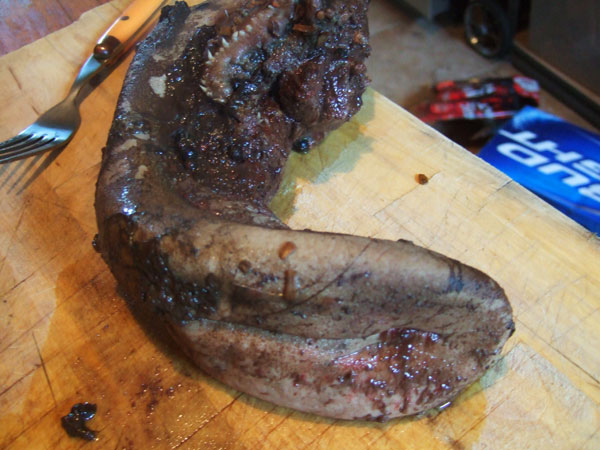

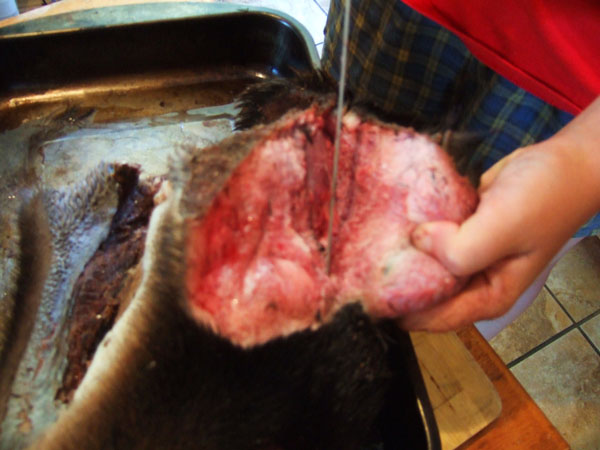
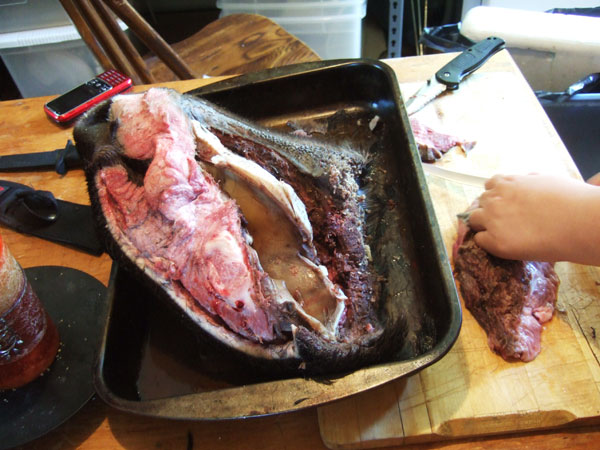
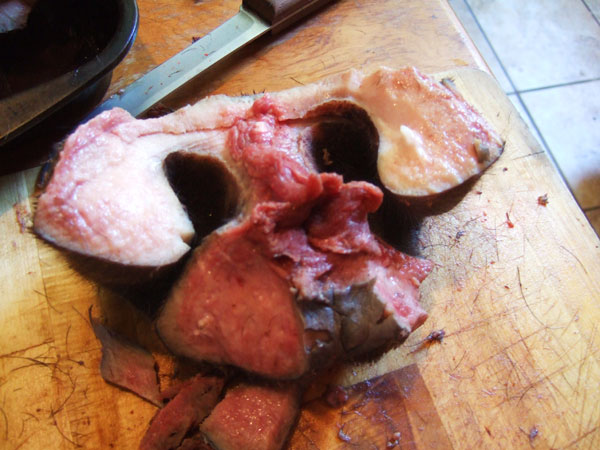
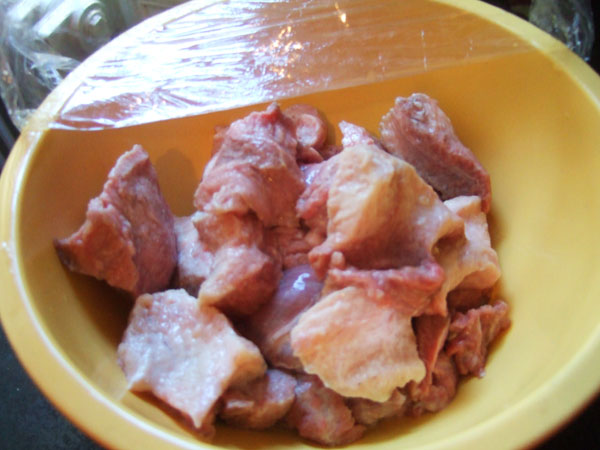
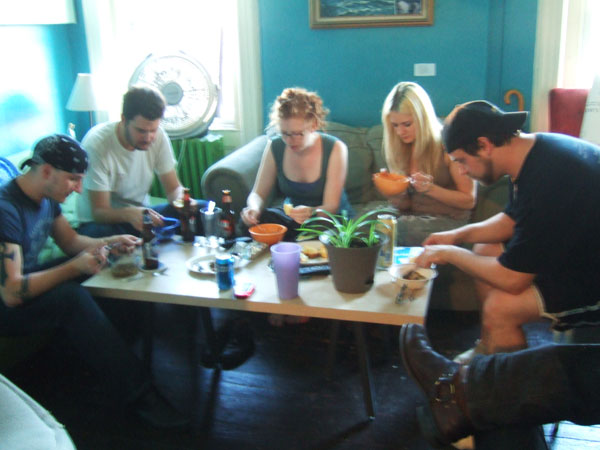
Good job. I’d think it is always an adventure to suck face with an Alaskan even a hairy one. The natives do prepare the noose sometimes. I’ll try to find out what they do with them. I was disappointed that the cartilage isn’t eaten, there certainly is a lot of it. The part that you did eat was probably some of the facial muscles that move the snout and a lot of fat that is in the cheeks. I just was an episode of Hairy Bikers (I think that’s the name) Where they went to a Mexican taco place that specialized in cooking whole Cow heads (skinned) then making a chopped meat out of it after removing the bones interesting. You never know what will show up next!
I especially liked the pictures.
Ha! thanks:) We did eat the muscle/fat in the cheek, which was tough and chewy, but we mostly ate the inside of the nose. It’s white and kinda muscle and kinda fat–I dunno. But we ate it!
Wow. just wow. Congratulations on your Alaskan Challenge! let us know if you need another ;) Second time is the charm?
I’ve worked with a lot of game, but this was a new one for me. Congratulations on a job well done! I do not live anywhere near moose country so I lived this adventure through your post.
I’d recommend moose meat f you can get it, but I think living vicariously through me in terms of mouffle is probably best.
Pingback: When it rains it pours: and now, a free workshop on cooking bears, beaver and moose | Brokelyn
Pingback: Episode 8: Sarah Lohman, part 2 « Alphabet Soup Podcast
Pingback: 9 mâncăruri bizare din organe de animale | inauntru.ro
Pingback: Party Time Reenactor: How to Drink Like an Ancient Greek « Four Pounds Flour
Pingback: A Chat with Sarah Lohman, Historic Gastronomist : How To Pickle A Sweater
Pingback: The History Dish: I Made Ambergris Ice Cream! « Four Pounds Flour
Pingback: One moose face, two puppets, and league of morons. | The Embiggens Project
Pingback: Lunch Date: Interview with Sarah Lohman – Why Kitchen
Pingback: How Just 8 Flavors Have Defined American Cuisine | MCC Neighborhoods
Cape Breton, Nova Scotia, we just harvested a moose, one guy wanted the heart for his brother, the next wanted the liver for an old friend, another grabbed the tongue, no one demanded the testicles, (also edible) but I wish I had brought the head home, having just discovered by accident this mouffle (nose and upper lip) recipe, maybe next year!
Pingback: My Top 5 Favourite Horse Parts – Confessions of a Middle-Aged Stable Boy
Hi Sara!
I’m a food anthropologist come writer at Atlas Obscura, and I’d love to get permission to use one (or a few) of these photos in an article we’re publishing about moose head stew. Would that be okay? We would use the photo on our website and to promote the article on social media. We’d of course give you credit and link back to your page. Please let me know!
Thanks,
Leigh
Sure, go for it. Yes links please, and credit all photos to Sarah Lohman
Well written,the narration almost fills the nostrils with sublime(?) aromas!
OMG, I just found this! Thank you so much for a good, bring-tears-to-my-eyes laugh!! I hope you have found better recipes since then.
Pingback: DiscoverNet | These Countries Prove You Should Be Eating Animal Heads
Thank you. I’ve been watching The Great, about Cathrine the Great of Russia. The kept referencing this dish on the show and was curious. Curiosity sated…..and thank you for your adventurous taste.
Pingback: site here